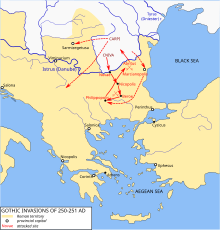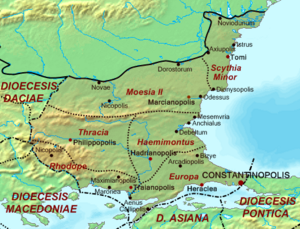Moesia

Moesia (/ˈmiːʃə, -siə, -ʒə/;[1][2] Latin: Moesia; Greek: Μοισία, romanized: Moisía)[3] was an ancient region and later Roman province situated in the Balkans south of the Danube River. As a Roman domain Moesia was administered at first by the governor of Noricum as 'Civitates of Moesia and Triballia'.[4] It included most of the territory of modern eastern Serbia, Kosovo, north-eastern Albania, northern parts of North Macedonia (Moesia Superior), Northern Bulgaria, Romanian Dobruja and small parts of Southern Ukraine (Moesia Inferior).
Geography
[edit]In ancient geographical sources, Moesia was bounded to the south by the Haemus (Balkan Mountains) and Scardus (Šar) mountains, to the west by the Drinus (Drina) river, on the north by the Donaris (Danube) and on the east by the Euxine (Black Sea).[5]
History
[edit]The region of Moesia was inhabited chiefly by Thracian, Illyrian, and Thraco-Illyrian peoples. The name of the region comes from Moesi, the Latin name of a Thracian tribe who lived there before the Roman conquest.
Parts of Moesia belonged to the polity of Burebista, a Getae (Dacian) king who established his rule over a large part of the northern Balkans between 82 BC and 44 BC. He led raids for plunder and conquest across Central and Southeastern Europe, subjugating most of the neighbouring tribes. After his assassination in a palace intrigue, the empire was divided into several smaller states.
In 74 BC, C. Scribonius Curio, proconsul of Macedonia, took an army as far as the Danube and chased the Geto-Dacians to the border of their remote country.[6]
The expansion of the Dacians on the middle and lower reaches of the Danube worried the Romans and destruction of Dacian power became one of Julius Caesar's key political objectives, who made plans to launch an offensive from Macedonia in about 44 BC.
Once Augustus had established himself as sole ruler of the Roman state in 30 BC after the battle of Actium, he took up Caesar's project and aimed to advance the empire's south-eastern European border from Macedonia to the line of the Danube. The main objective was to increase strategic depth between the border and Italy and also to provide a major river supply route between the Roman armies in the region.[7] The lower Danube was given priority over the upper Danube and required the annexation of Moesia. It was therefore necessary to conquer the tribes who dwelt south of the Danube namely (from west to east) the Triballi, Moesi, Getae and the Bastarnae who had recently subjugated the Triballi, and with their capital at Oescus.[8] Augustus also wanted to avenge the defeat of Gaius Antonius Hybrida at Histria 32 years before and to recover the lost military standards held in the powerful fortress of Genucla.[9]
Marcus Licinius Crassus, grandson of Crassus the triumvir was appointed for the task.[5] He was an experienced general at 33 years of age, and proconsul of Macedonia from 29 BC.[10] After a successful campaign against the Moesi, he drove the Bastarnae back toward the Danube and finally defeated them in pitched battle, killing their King Deldo in single combat.[11] Augustus formally proclaimed this victory in 27 BC in Rome but blocked Cassius' entitlement to the Spolia opima and use of the term imperator apparently in favour of his own prestige.
Moesia was split off as a separate military command some time before 10 BC.[12]
As a result of the Dacians constant looting that occurred whenever the Danube froze, Augustus decided to send against them some of his proven generals such as Sextus Aelius Catus and Gnaeus Cornelius Lentulus Augur (sometime between 1-11 AD[13]). Lentulus pushed them back across the Danube and placed numerous garrisons on the right bank of the river to defend against possible and future incursions.[14] These became the Moesian Limes frontier defensive system that was developed further later.
Roman Province
[edit]The region, however, was not organised as a province until the last years of Augustus' reign; in 6 AD, mention is made of its governor, Caecina Severus.[15] As a province, Moesia was under an imperial consular legate (who probably also had control of Achaea and Macedonia).[5] In 15 AD complaints about the corruption of the governors of Macedonia and Achaia led Tiberius to put these provinces under the control of the governor of Moesia.[16]
In 86 AD the Dacian king Duras attacked Moesia after which the Roman emperor Domitian personally arrived in Moesia and reorganised it in 87 into two provinces, divided by the river Cebrus (Ciabrus):[5] to the west Moesia Superior (meaning upriver) and to the east Moesia Inferior or Ripa Thracia (from the Danube river's mouth and then upstream). Each was governed by an imperial consular legate and a procurator.[5]
From Moesia Domitian began planning future campaigns into Dacia and Domitian's Dacian War started by ordering General Cornelius Fuscus to attack who, in the summer of 87, led five or six legions across the Danube. The war ended without a decisive outcome and Decebalus, the Dacian King, later brazenly flouted the terms of the peace (89 AD) which had been agreed on.
Dacian Wars
[edit]Trajan's Dacian Wars (101–102 AD, 105–106 AD) were two military campaigns fought between the Roman Empire and Dacia during Emperor Trajan's rule. The conflicts were triggered by the constant Dacian threat on Moesia and also by the increasing need for resources of the economy of the Empire.
Starting with AD 85, Dacia was unified under King Decebalus. Following an incursion into Moesia, which resulted in the death of its governor, Gaius Oppius Sabinus, a series of conflicts between the Romans and Dacians ensued. Although the Romans gained a major strategic victory at Tapae in AD 88, Emperor Domitian offered the Dacians favourable terms, in exchange for which Roman suzerainty was recognised. However, Emperor Trajan restarted the conflicts in 101-102 and then again in 105–106, which ended with the annexation of most of Dacia and its reorganisation as a Roman Province.[17]
Gothic raids
[edit]
The first incursion in Moesia that can be attributed to Goths is by the Costoboci in 170 in the Marcomannic Wars when they destroyed Tropaeum Traiani.[18]
In 238 the Carpi sacked Histria and Tropaeum Traiani.[19] Afterwards Moesia was frequently invaded or raided by the Dacian Carpi, and the East Germanic tribes of the Goths.
In the Gothic War (248–253), the Gothic king Cniva captured the city of Philippopolis and then inflicted a devastating defeat upon the Romans at the Battle of Abrittus, in which the Roman Emperor Decius was killed,[20] one of the most disastrous defeats in the history of the Roman army.[21]
Retreat from Dacia
[edit]
After the abandonment of Roman Dacia to the Goths by Aurelian (270–275) and the transfer of the Roman citizens from the former province to the south of the Danube, the central portion of Moesia took the name of Dacia Aureliana (later divided into Dacia Ripensis[5] and Dacia Mediterranea).
During administrative reforms of Emperor Diocletian (284–305), both of the Moesian provinces were reorganised. Moesia Superior was divided in two, northern part forming the province of Moesia Prima including cities Viminacium and Singidunum, while the southern part was organised as the new province of Dardania with cities Scupi and Ulpiana. At the same time, Moesia Inferior was divided into Moesia Secunda and Scythia Minor.

As a frontier province, Moesia was strengthened by stations and forts erected along the southern bank of the Danube, and a wall was built from Axiopolis to Tomis as a protection against the Scythians and Sarmatians.[5] The garrison of Moesia Secunda included Legio I Italica and Legio XI Claudia, as well as auxiliary infantry units, cavalry units, and river flotillas.
Hard-pressed by the Huns, the Goths again crossed the Danube during the reign of Valens (376) and with his permission settled in Moesia.[5] After they settled, quarrels soon took place, and the Goths under Fritigern defeated Valens in a great battle near Adrianople. These Goths are known as Moeso-Goths, for whom Ulfilas made the Gothic translation of the Bible.[5]
Late Empire
[edit]The Slavs allied with the Avars invaded and destroyed much of Moesia in 583–587 in the Avar–Byzantine wars. Moesia was settled by Slavs during the 7th century. Bulgars, arriving from Old Great Bulgaria, conquered Lower Moesia by the end of the 7th century. During the 8th century the Byzantine Empire lost also Upper Moesian territory to the First Bulgarian Empire.[citation needed]. The region would return to Byzantine control under Basil II in 1018 and would last until the formation of the Second Bulgarian Empire in 1185.
See also
[edit]- Diocese of Moesia
- Dacia Aureliana
- List of ancient cities in Thrace and Dacia
- List of Roman governors of Moesia
- List of Roman governors of Lower Moesia
- List of Roman governors of Upper Moesia
- Inscriptions of Upper Moesia
- Moesogoths
- Margus (city)
References
[edit]- ^ Lena Olausson; Catherine Sangster, eds. (2006). Oxford BBC Guide to Pronunciation. Oxford University Press.
- ^ Daniel Jones (2006). Peter Roach; James Hartman; Jane Setter (eds.). Cambridge Pronouncing Dictionary. Cambridge University Press.
- ^ "C. Suetonius Tranquillus, Vitellius Maximilian Ihm, Ed". perseus.tufts.eud.
- ^ (p. 581) ISBN 9780521264303 Bowman, Alan K.; Champlin, Edward; Lintott, Andrew (8 February 1996). The Cambridge Ancient History, Том 10. Cambridge University Press. ISBN 978-0-521-26430-3.
- ^ a b c d e f g h i Freese, John Henry (1911). . In Chisholm, Hugh (ed.). Encyclopædia Britannica. Vol. 18 (11th ed.). Cambridge University Press. pp. 643–644.
- ^ Georgescu, Vlad (1991). Călinescu, Matei (ed.). The Romanians: a history. Romanian literature and thought in translation series. Columbus, Ohio: Ohio State University Press. ISBN 978-0-8142-0511-2 p. 4.
- ^ Res gestae divi Augusti (Monumentum Ancyranum) 30 = Dobó, Inscriptiones... 769
- ^ Ptolemy
- ^ Dio LI.26.5
- ^ Dio LI.23.2
- ^ Cassius Dio 51.23.3 ff. [1]
- ^ Vanderspoel, John (2010). "Provincia Macedonia". In Roisman, Joseph; Worthington, Ian (eds.). A companion to ancient Macedonia. Chichester: Blackwell Publishing. pp. 269–270. ISBN 978-1-405-17936-2.
- ^ R. Syme, Danubian Papers, London 1971, p. 40 and Addenda p. 69 ff
- ^ Florus, Epitome of Roman History, II, 28, 18-19.
- ^ Cassius Dio, lv.29
- ^ Tacitus, Annales 1.76.4
- ^ "Dacia | Europe, Map, Culture, & History | Britannica". www.britannica.com. 3 October 2024. Retrieved 13 October 2024.
- ^ Kovács, Péter (2009). Marcus Aurelius' rain miracle and the Marcomannic wars. Brill. p 198
- ^ Bennett, Matthew (2004). "Goths". In Holmes, Richard; Singleton, Charles; Jones, Spencer (eds.). The Oxford Companion to Military History. Oxford University Press. p. 367. ISBN 978-0191727467
- ^ Wolfram, Herwig (1990). History of the Goths. Translated by Dunlap, Thomas J. University of California Press. ISBN 0520069838 p=128
- ^ Heather, Peter (2010). Empires and Barbarians: The Fall of Rome and the Birth of Europe. Oxford University Press. ISBN 978-0199892266 pp=109–20
Further reading
[edit]- András Mócsy, Pannonia and Upper Moesia: A History of the Middle Danube Provinces of the Roman Empire, Routledge Revivals Series, 2014. ISBN 9781317754251
- Conor Whately, Exercitus Moesiae: The Roman Army in Moesia from Augustus to Severus Alexander. BAR international series, S2825. Oxford: 2016. ISBN 9781407314754
- Bowman, Alan K.; Champlin, Edward; Lintott, Andrew (1996). The Cambridge Ancient History, Том 10. Cambridge University Press. ISBN 9780521264303.
External links
[edit]- Moesia
- Ancient history of the Balkans
- Provinces of the Roman Empire
- Romanization of Southeastern Europe
- Historical regions in Bulgaria
- Historical regions in Romania
- Historical regions in Serbia
- Ancient Bulgaria
- Ancient history of Romania
- Ancient history of Serbia
- Ancient history of Ukraine
- Roman Balkans
- Bulgaria in the Roman era
- Serbia in the Roman era
- Šar Mountains
- Former countries in the Balkans

